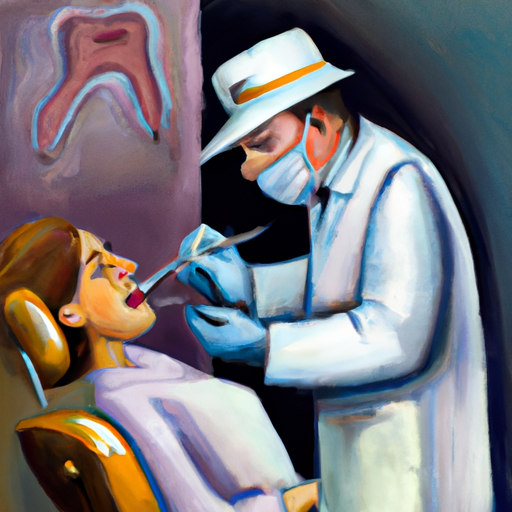Endodontic treatment, also known as root canal therapy, is a dental procedure that aims to save a tooth from extraction by removing the infected or damaged pulp from its interior. It is a crucial procedure in the field of dentistry and has become a common practice to preserve teeth that would otherwise be lost. In this article, we will take an in-depth look at endodontic treatment, exploring its diagnosis, treatment procedures, symptoms, causes, and prevention methods. By understanding the various aspects of endodontic treatment, you will be equipped with the knowledge to make informed decisions about your dental health and maintain a healthy, radiant smile.
1. "Understanding Endodontic Treatment: An In-Depth Look at Diagnosis and Treatment"
Endodontic treatment, also known as root canal therapy, is a dental procedure aimed at saving a tooth that has suffered from severe decay or infection. It involves the removal of the infected or damaged pulp, which is the soft tissue inside the tooth, and the subsequent cleaning, disinfection, and sealing of the root canals. This article provides an in-depth look at the diagnosis and treatment process involved in endodontic treatment.
Diagnosing the need for endodontic treatment begins with a comprehensive examination conducted by a dentist or endodontist. The first step involves a thorough evaluation of the patient’s dental history, including any previous dental treatments, symptoms, and complaints. The dentist will then perform a physical examination, visually inspecting the affected tooth and surrounding tissues for any signs of infection or inflammation.
In addition to the physical examination, various diagnostic tools are used to assess the condition of the tooth. X-rays are commonly employed to visualize the internal structures of the tooth, such as the root canals and surrounding bone. X-ray images can reveal signs of infection, decay, or other abnormalities that may necessitate endodontic treatment.
Apart from X-rays, the dentist may also employ other advanced imaging techniques such as cone-beam computed tomography (CBCT) to obtain a three-dimensional view of the tooth’s anatomy. CBCT scans provide more detailed information about the root canal system, allowing for a more accurate diagnosis and treatment planning.
Symptoms that may indicate the need for endodontic treatment include persistent tooth pain, sensitivity to hot or cold temperatures, swelling or tenderness in the gums, and the presence of a pimple-like bump on the gum near the affected tooth. However, it is important to note that not all cases exhibit noticeable symptoms, and sometimes a tooth may require endodontic treatment even without apparent signs of infection.
Once the need for endodontic treatment has been confirmed, the dentist or endodontist will proceed with the actual treatment. The first step involves administering local anesthesia to ensure the patient’s comfort throughout the procedure.
2. "Recognizing the Symptoms and Causes of Endodontic Issues: What You Need to Know"
Endodontic issues can be a cause of concern for many individuals, as they can lead to severe pain and discomfort. Recognizing the symptoms and causes of these problems is essential in order to seek timely diagnosis and treatment. By understanding the signs and underlying factors, individuals can take proactive measures to prevent or address endodontic issues effectively.
One of the primary symptoms of endodontic problems is persistent tooth pain. This pain can range from a dull ache to sharp and intense sensations. It may worsen while chewing or applying pressure on the affected tooth. Additionally, sensitivity to hot or cold temperatures, as well as sweet or acidic foods, may also indicate the need for endodontic treatment. Swelling or tenderness in the surrounding gum area is another common symptom that should not be ignored.
Endodontic issues are typically caused by dental decay, trauma to the tooth, or deep cracks or fractures in the tooth structure. Dental decay occurs when bacteria in the mouth produce acids that gradually erode the tooth enamel, leading to cavities. If left untreated, this decay can progress to the innermost layer of the tooth, known as the pulp, resulting in infection and inflammation. Trauma to the tooth, such as a sports injury or accident, can also damage the pulp and necessitate endodontic treatment. Moreover, deep cracks or fractures in the tooth can provide an entry point for bacteria, causing infection and inflammation.
It is crucial to note that sometimes endodontic issues may be asymptomatic, meaning there are no apparent signs of a problem. Regular dental check-ups are essential in detecting these issues early on, as dentists can perform various diagnostic tests to identify any underlying endodontic concerns. X-rays, pulp testing, and visual examinations allow dentists to assess the health of the tooth’s pulp and determine the appropriate course of action.
If the symptoms and causes of an endodontic issue are recognized, it is vital to seek professional dental care promptly. Endodontic treatment, commonly known as a root canal, is often the recommended course of action
3. "Exploring the Various Aspects of Endodontic Treatment: From Diagnosis to Prevention"
Endodontic treatment is a specialized dental procedure that focuses on the diagnosis, treatment, and prevention of diseases and injuries affecting the dental pulp. This article will delve into the various aspects of endodontic treatment, starting from the initial diagnosis to the prevention of future complications.
Diagnosis is the first step in endodontic treatment. A skilled endodontist will carefully examine the patient’s dental history, perform a thorough clinical examination, and utilize advanced diagnostic tools such as dental X-rays and digital imaging to identify the underlying cause of the problem. Symptoms such as tooth sensitivity, severe toothache, swelling, and gum tenderness may indicate the need for endodontic intervention.
Once the diagnosis is confirmed, the main goal of endodontic treatment is to save the natural tooth. The most common procedure performed is root canal therapy, which involves the removal of infected or damaged pulp from the tooth’s root canal system. This is followed by cleaning, shaping, and filling the canals with a biocompatible material to prevent reinfection.
During the treatment, local anesthesia is administered to ensure the patient’s comfort. The endodontist will use specialized tools and techniques to access the root canal system and remove the infected tissue. Advanced technology, such as dental operating microscopes and rotary instruments, enables precise and efficient treatment, leading to better outcomes.
Post-treatment care is crucial to ensure the success of endodontic treatment. Patients might experience mild discomfort or sensitivity for a few days following the procedure, and over-the-counter pain relievers can help alleviate any discomfort. It is important to follow the endodontist’s instructions regarding oral hygiene practices and medication use. Regular dental check-ups are advised to monitor the healing process and ensure the tooth remains healthy.
Prevention plays a significant role in maintaining oral health and avoiding the need for endodontic treatment. Maintaining good oral hygiene practices, such as brushing twice a day, flossing regularly, and visiting the dentist for routine check-ups, can help prevent tooth decay and gum disease, which are common causes of endodont



